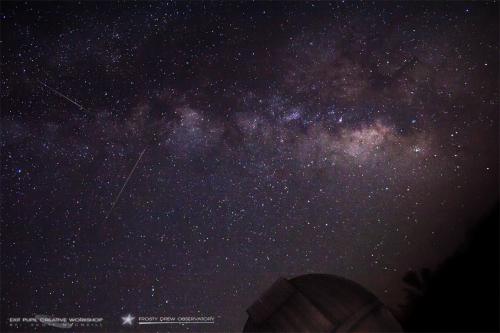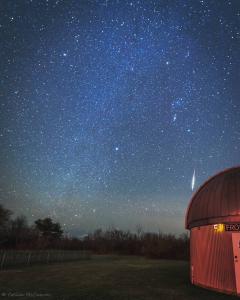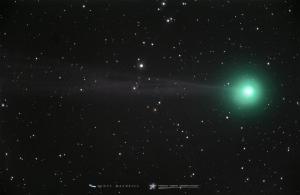Celebration of Space - May 1, 2020
During the morning hours on Tuesday, May 5, 2020, the annual Eta Aquariid Meteor Shower will peak. Bringing with it an increase in regular meteor activity by around 40 meteors per hour, the Eta Aquarrids are a good shower to observe. Now that rate is under fantastic viewing conditions. Which means no clouds, no Moon) and when the radiant point of the shower, where all meteors appear to originate from, is well above the horizon. This Tuesday, we will have the 91% waxing gibbous Moon, which will certainly steal the show. The Eta Aquariid shower is a result of comet 1P / Halley (Halley’s Comet). As Halley’s Comet makes its 75 year orbit around the Sun, it leaves behind a trail of tiny comet particles. These particles are dust and rice grain sized pieces of ice and rock. When the comet starts to approach the Sun, its interaction with the solar wind heats up the comet’s nucleus, causing it to out-gas. This out-gassing will release a lot of loose particles on the comet, which causes the debris field to form. As Earth orbits through the debris field, the tiny particles of comet are captured by Earth’s gravity and enter Earth’s atmosphere at rates of 42 miles per second. The mass of Earth’s atmosphere is too great for the speed so the tiny particles burn up, leaving streaks across the sky.
Viewing the Eta Aquariid meteor shower will be a bit difficult this year due to the copious amounts of moonlight to contend with. There will be no escaping to a dark location. Find a spot with a wide open view of the sky, lay on your back with your feet to the NW and look upwards toward zenith (top of sky) to see meteors passing by. If possible align yourself so the Moon is out of your view or blocked by a tree or structure. This will help get some of the bright moonlight out of your face. Meteors will appear to radiate from the star Eta Aquarius, which is where the shower gets its name from. Good luck!
A few weeks ago we wrote about the untimely demise of Comet C/2019 Y4 Atlas, as well as the addition of a newly discovered comet C/2020 F8 SWAN (Comet SWAN), which could become quite remarkable. Well skip ahead to now and Comet SWAN has been exceeding expectations! Over the last couple of weeks a fantastic tail has formed along the comet’s path, reminiscent of Comet C/2014 Q2 Lovejoy in early 2015. Additionally, as of this morning, Comet SWAN has brightened past the point of naked eye visibility. Though dim, the comet is currently naked eye visible depending on your location. Unfortunately, Comet SWAN is still poorly aligned for Northern Hemisphere observation, though we will get our chance to view in the coming weeks. With May 19, 2020 slated as the first night to really catch a good look. Here is the problem with views for us in the North.
Comet SWAN is inclined 111° to the ecliptic (plane of the Solar System), and it is currently below the ecliptic. Since Comet SWAN is currently closer to the Sun than Earth, we have to look towards the Sun to see. It is also in the western quadrature (west side of the Sun as appears in the sky), causing it to set before the Sun, so we have to look in the morning, before sunrise. Since we are about 1.5 months away from the Summer Solstice in the Northern Hemisphere, we are approaching our maximum tilt towards the Sun, which places the ecliptic very low in the night sky. Being that Comet SWAN is below the ecliptic, it hardly gets over the horizon before the Sun rises. On the morning of May 10, 2020, the comet will cross the ecliptic, becoming visible in the Northern Hemisphere sky. Unfortunately, the Moon will be in its waning gibbous phase and in the morning sky during that time. We will have to wait until May 19th for the Moon to wane enough for an easy view. Astronomical chances huh…?
Regardless, if the comet survives its approach to the Sun, we could be in for fabulous views! At Frosty Drew, we are anxiously waiting for a chance to image the comet, and will be posting a lot about Comet C/2020 F8 SWAN over the next month. So let’s hope for a beautiful comet to ease us back into regular life, in the morning to welcome the new day. In the meantime, get excited with this picture of Comet SWAN from mid-April.
We hope you are all doing well and surviving the stresses of the global lock down. We are anxious to welcome all of you back to Frosty Drew Observatory. It’s quite lonely out there all by ourselves, but we have the stars to keep us company.
- Author:
- Scott MacNeill
- Entry Date:
- May 1, 2020
- Published Under:
- Scott MacNeill's Columns




